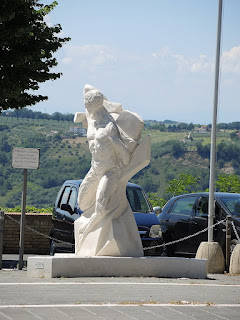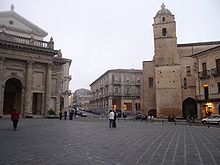Heroic group of partisans earned Gold Medal for Valour
 |
| A statue in the town of Lanciano honours partisan leader Trentino La Barba |
The group became known as the Martiri ottobrini di Lanciano - the October Martyrs of Lanciano. Their deeds were recognised by the postwar Italian government with the award - to all the citizens of the town - of the Gold Medal for Military Valour, and there are a number of monuments in the town that commemorate the event and the participants.
As well as 11 partisan resistance fighters, another 12 Lancianese who fought alongside them were killed by the Germans. The leader of the partigiani group, a 28-year-old former soldier named Trentino La Barba, was posthumously awarded the Gold Medal for Valour in his own right. Three others were honoured with Silver Medals.
Lanciano - 22km (14 miles) southeast of the city of Chieti and about 30km (19 miles) from the coastal resort of Pescara - had the misfortune to be one of the key municipalities close to the Gustav Line, one of the major defensive lines established by the Germans to counter the Allied invasion of the Italian peninsula.
As such, it was in the line of fire for many months, over which time around 500 civilians were killed in the bombardments that regularly took place. The citizens of Lanciano also found themselves often deprived of food and supplies that instead went to the German military.
 |
| The Torri Montanare were an important strategic capture by the partisans |
One of the founder members of the Gran Sasso resistance group, La Barba - emboldened by news that Allied troops had landed at Termoli, just 72km (45 miles) away from Lanciano - had stolen weapons from a Carabinieri barracks on October 4, hid them in a cave at nearby Pozzo Bagnaro, just outside the town, and the following night launched an attack on a German column.
His guerrilla group entered the town at Porta San Biagio, a gate in the ancient walls, setting fire to some German vans, but German reinforcements arrived and La Barba was captured. He was interrogated and tortured, then taken to the centre of the town, where he was shot and his body hung from a tree, which the Germans hoped would deter the local population from further insurgence.
Instead, as the remainder of La Barba’s group fought on and occupied a number of strategic points, including the Torri Montanare in the ancient walls, many local people joined the fight. A number of partisans died in a battle near Porta Santa Chiara, but the rest of the brigade was able to move into the historic centre.
 |
| The Piazza del Plebiscito, where Lanciano's liberation was celebrated |
In any case, the German divisions were soon occupied with fighting Allied troops, who were approaching ever closer to the Gustav Line. Lanciano found itself bombarded repeatedly, with many historic buildings damaged or destroyed.
It was finally liberated on December 3, when sections of the 8th Indian Division and the 78th English Division, part of the British 8th Army fighting the important Battle of the Sangro River, arrived at the convent of Sant'Antonio di Padova.
The Indian troops, accompanied by some local Italian officials who had come out of hiding on their arrival, marched triumphantly along Corso Trento and Trieste to Piazza Plebiscito, the town’s main square.
The active participation of Lanciano’s citizens in the Italian Resistance was recognised in 1952, when Lanciano was awarded the Gold Medal for Military Valour by President Luigi Einaudi.
In the 1970s, a commemorative monument was created at Piazzale VI Ottobre at the beginning of Via Ferro di Cavallo, in memory of the martyrs, while in 2016 a statue by the sculptor Nicola Antonelli was erected in Largo dell'Appello, depicting Trentino La Barba.
 |
| The Diocletian Bridge and bell tower of the Basilica |
Situated about 10km (6.2 miles) from the port of Ortona on the Adriatic coast, Lanciano sits on a group of hills rising to about 265 metres (869 feet) above sea level. Formerly the Roman city of Anxanum, Lanciano has another claim to historical fame as the site of what is recognised as the first Eucharistic Miracle of the Catholic Church, which took place in the eighth century, when a monk having doubts about the real presence of Christ in the Eucharist - also known as Holy Communion - found when he said the words of consecration at Mass that the bread and wine changed into flesh and blood. Lanciano today has a number of churches, including the 17th century Basilica Santa Maria del Ponte, named after the adjoining Ponte Diocleziano - the Diocletian Bridge - a Roman relic from the late third century. Panoramic views can be had from the two Torri Montanare, which used to form an important part of the town’s mediaeval defensive walls.
 |
| Part of Ortona's Castello Aragonese, the coastal town's dominant historic feature |
Nearby Ortona, which can be found about 22km (14 miles) south of Pescara along the Adriatic coast and about 26km (16 miles) east of the provincial capital Chieti, is dominated by a huge 15th century Aragonese castle, a legacy of another major battle when Ortona came under heavy attack by the Venetian navy in 1447. The castle has been renovated and visitors can reach it by walking along the Passegiatta Orientale, which looks out over the coastline. Ortona’s Cathedral of Saint Thomas contains remains of Saint Thomas the Apostle, which were brought to Ortona by sea in the 13th century more than 1,200 years after his death in India. Ortona was also badly damaged in World War Two, the port being the scene of one of the bloodiest battles of the Allies’ Italian Campaign a short time after Lanciano was liberated. Ortona has a museum dedicated to the December 1943 battle.
Also on this day:
1888: The birth of wartime nurse Saint Maria Bertilla Boscardin
1935: The birth of wrestling champion Bruno Sammartino
1943: The birth of football coach Ottavio Bianchi